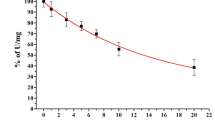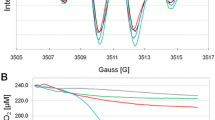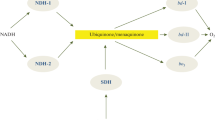Abstract
Aerobic incubations of bleomycin, FeCl3, DNA, NADPH, and isolated liver microsomal NADPH-cytochrome P-450 reductase resulted in NADPH and oxygen consumption and malondialdehyde formation, indicating that the deoxyribose moiety of DNA was split. All parameters measured depended on the active enzyme, bleomycin and FeCl3. In the absence of oxygen malondialdehyde formation was very low.
When bleomycin, FeCl3 and the reductase were incubated with methional ethene (ethylene) was formed, suggesting that during the enzyme-catalyzed redox cycle of bleomycin-Fe(III/II) hydroxyl radicals were formed. Ethene formation also depended on oxygen, NADPH, the enzyme, bleomycin, and FeCl3.
During aerobic incubations of bleomycin, FeCl3, NADPH, and isolated liver nuclei oxygen and NADPH were consumed and malondialdehyde was formed. Oxygen and NADPH consumption and malondialdehyde formation depended on bleomycin and FeCl3. In the absence of oxygen malondialdehyde was not formed. These results indicate that nuclear NADPH-cytochrome P-450 reductase redox cycles the bleomycin-Fe(III/II) complex and that the reduced complex activates oxygen, whereby hydroxyl radicals are formed which damage the deoxyribose of nuclear DNA.
Similar content being viewed by others
References
Berend N (1984) Protective effect of hypoxia on bleomycin lung toxicity in the rat. Am Rev Respir Dis 130: 307–308
Bishun NP, Smith NS, Williams DC (1978) Bleomycin (review). Oncology 35: 228–234
Burger RM, Peisach J, Horwitz SB (1981) Mechanism of bleomycin action: In vitro studies (minireview). Life Sci 28: 715–727
Carter SK, Crooke ST, Umezawa H (1978) Bleomycin, current status and new developments. Academic Press, New York
Chandler DB, Fulmer JD (1985) The effect of deferoxamine on bleomycin-induced lung fibrosis in the hamster. Am Rev Respir Dis 131: 596–598
Cunningham ML, Ringrose PS, Lokesh BR (1983) Bleomycin cytotoxicity is prevented by superoxide dismutase in vitro. Cancer Lett 21: 149–153
Cunningham ML, Ringrose PS, Lokesh BR (1984) Inhibition of the genotoxicity of bleomycin by superoxide dismutase. Mutat Res 135: 199–202
Gebbers JO, Burkhardt A (1982) Pulmonary lesions induced by bleomycin. In: Zbinden G (ed) Lectures in toxicology. Pergamon Press, Oxford, pp 1–6
Giloni L, Takeshita M, Johnson F, Iden C, Grollman AP (1981) Bleomycin-induced strand-scission of DNA — mechanism of deoxyribose cleavage. J Biol Chem 256: 8608–8615
Grollman AP, Takeshita M, Pillai KMR, Johnson F (1985) Origin and cytotoxic properties of base propenals derived from DNA. Cancer Res 45: 1127–1131
Gutteridge JMC, Rowley DA, Halliwell B (1981) Superoxide-dependent formation of hydroxyl radicals in the presence of iron salts. Biochem J 199: 263–265
Kappus H, Mahmutoglu I (1986) Oxygen radical formation during redox cycling of bleomycin-Fe(III) catalyzed by NADPH-cytochrome P-450 reductase of liver microsomes and nuclei. In: Kocsis JJ, Jollow DJ, Witmer ChM, Nelson JO, Snyder R (eds) Biological reactive intermediates III — Mechanisms of action in animal models and human disease, Plenum Press, New York, pp 273–280
Kappus H, Kieczka H, Scheulen M, Remmer H (1977) Molecular aspects of catechol and pyrogallol inhibition of liver micro-somal lipid peroxidation stimulated by ferrous ion-ADP-complexes or by carbon tetrachloride. Naunyn-Schmiedeberg's Arch Pharmacol 300: 179–187
Kappus H, Muliawan H and Scheulen ME (1982) Liver microsomal lipid peroxidation by bleomycin-ferrous-oxygen-complexes. In: Sato R, Kato R (eds) Microsomes, drug oxidations, and drug toxicity. Japan Scientific Societies Press, Tokyo New York, pp 555–556
Kilkuskie RE, Macdonald TL, Hecht SM (1984) Bleomycin may be activated for DNA cleavage by NADPH-cytochrome P-450 reductase. Biochemistry 23: 6165–6171
Mahmutoglu I, Kappus H (1985) Oxy radical formation during redox cycling of the bleomycin-iron(III) complex by NADPH-cytochrome P-450 reductase. Biochem Pharmacol 34: 3091–3094
Pepin JM, Langner RO (1985) Effects of dimethyl sulfoxide (DMSO) on bleomycin-induced pulmonary fibrosis. Biochem Pharmacol 34: 2386–2388
Povirk LF (1983) Bleomycin. In: Neidle S, Waring MJ (eds) Molecular aspects of anti-cancer drug action. Topics in molecular and structural biology, vol 3. Macmillan Press, London, pp 157–181
Romano M, Clos V, Assael BM, Salmona M (1982) Perinatal development of cytochrome P-450, NADPH-cytochrome c reductase and ethoxycoumarin deethylase in rat liver nuclear membranes. Chem Biol Interact 42: 225–231
Romano M, Facchinetti T, Salmona M (1983) Is there a role for nuclei in the metabolism of xenobiotica — a review. Drug Metab Rev 14: 803–829
Sagara Y, Harano T, Omura T (1978) Characterization of electron transport enzymes in the envelope of rat liver nuclei. J Biochem (Tokyo) 83: 807–812
Sausville EA, Peisach J, Horwitz SB (1978) Effect of chelating agents and metal ions on the degradation of DNA by bleomycin. Biochemistry 17: 2740–2746
Scheulen ME, Kappus H, Thyssen D, Schmidt CG (1981) Redox cycling of Fe(III)-bleomycin by NADPH-cytochrome P-450 reductase. Biochem Pharmacol 30: 3385–3388
Scheulen ME, Kappus H (1984) The activation of oxygen by bleomycin is catalyzed by NADPH-cytochrome P-450 reductase in the presence of iron ions and NADPH. In: Bors W, Saran M, Tait D (eds) Oxygen radicals in chemistry and biology, de Gruyter, Berlin New York, pp 425–433
Trush MA, Mimnaugh EG, Ginsburg E, Gram TE (1982) Studies on the interaction of Bleomycin A2 with rat lung microsomes. I. Characterization of factors which influence bleomycin-mediated DNA chain breakage. J Pharmacol Exp Ther 221: 152–158
Wu JC, Kozarich JW, Stubbe JA (1983) The mechanism of free base formation from DNA by bleomycin. J Biol Chem 258: 4694–4697
Yamanaka N, Kato T, Nishida K, Ota K (1978) Enhancement of DNA chain breakage by bleomycin A2 in the presence of microsomes and reduced nicotinamide adenine dinucleotide phosphate. Cancer Res 38: 3900–3903
Author information
Authors and Affiliations
Additional information
Dedicated to Professor Dr. med. Herbert Remmer on the occasion of his 65th birthday
Rights and permissions
About this article
Cite this article
Mahmutoglu, I., Scheulen, M.E. & Kappus, H. Oxygen radical formation and DNA damage due to enzymatic reduction of bleomycin-Fe(III). Arch Toxicol 60, 150–153 (1987). https://doi.org/10.1007/BF00296969
Issue Date:
DOI: https://doi.org/10.1007/BF00296969




